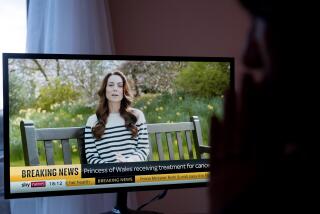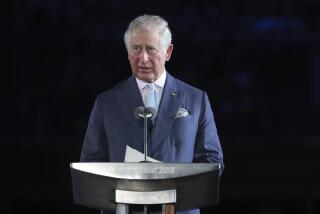Peek Over Royal Transom Finds Truly Lurid Past Misbehaviors : Britain: Historians say ho-hum to current spate of indiscretions. Take King Charles II, for instance, with at least a dozen illegitimate children and many mistresses.
LONDON — Have you heard the latest about Prince Charles and Princess Diana? The latest is, royal shenanigans are nothing new. Marriage problems, indeed, are old, old news in the history of the British monarchy.
The Prince of Wales, the prospective King Charles III, has been portrayed as cold and indifferent to his princess, and attached to an old flame. He has been photographed kissing other women on the cheek and has missed his son’s sports day at school.
Pale stuff. His very eponym, King Charles II, had at least a dozen illegitimate children and many mistresses--three of whom figure in the family tree of Princess Diana.
Henry II and George I had their wives locked up. Henry VIII, in a category all his own, had two of his six wives beheaded.
Royal marriages have long been objects of public fascination, bawdy ballads and nosy newspaper articles.
“The poor Princess of Wales,” wrote one commentator. “Surely her fate has been a hard one and no less so to have fallen into the hands of her present advisers whose only object in making these scandalous anecdotes public is to disgrace the royal family in the eyes of the public.”
The commentator was Sir Walter Scott, writing nearly 200 years ago about the public recriminations between the future George IV and his neglected wife.
George was a womanizer, a dandy and a spendthrift. He bought enormous quantities of clothes at great expense--black silk drawers, white kid gloves, embroidered vests, doeskin pantaloons.
While still the Prince of Wales, he married the Catholic widow Maria Fitzherbert, illegally, without his father the king’s permission.
When his debts became intolerable, he had no compunction about improving his financial position by marrying his German cousin, Princess Caroline of Brunswick, a coarse, fun-loving woman whom he had never met.
Caroline, the very opposite of the present Princess of Wales, was no beauty. Also, we are told, she bathed infrequently and couldn’t begin to match the fashion sense of her perfumed, beribboned fiance.
When they met shortly before the wedding, the prince slumped into a corner and said: “I am not well. Pray get me a glass of brandy.”
They were married April 8, 1795, George heavily fortified with drink. Nine months later the queen bore a daughter, Charlotte. With an heir provided, the royal marriage was effectively over.
George moved out, humiliating his wife, and carried on his affairs as before. By 1800, Mrs. Fitzherbert had him back.
Caroline and George took their feud to the press. “Friends” of each saw to it that the newspapers were supplied with information damaging to the other, Christopher Hibbert says in his biography, “George IV.”
Caroline was believed to have had an illegitimate child, and after several years of outraging her husband by her indiscretions, moved to Italy. Word of her close relationship with Bartolommeo Pergami, the head of her household, got back to London.
George had acted as regent from 1811 when his father, George III, was incapacitated by mental illness. He became king on his father’s death in 1820.
King and government tried to bribe Caroline to stay out of England. George attempted to have her tried in Parliament for “indecent and offensive familiarity and freedom” with Pergami, but the case was abandoned.
So, on July 19, 1821, the queen progressed to Westminster Hall for the coronation, and found the doors shut in her face.
Caroline took ill and died Aug. 8. She asked to be buried in her native land in a coffin inscribed, “Caroline of Brunswick, the injured Queen of England.”
Even then an “injured queen” was nothing new.
Seven centuries earlier Eleanor of Aquitaine, who was imprisoned by her husband, Henry II, outlived him and styled herself “Eleanor, by the wrath of God, Queen of England.”
In the marriages of kings, where love was often less important than dowries and alliances, the marriage of Henry and Eleanor was a merger on a grand scale.
As Amy Kelly wrote in her biography of Eleanor of Aquitaine, “the property value of great heiresses made it impractical for feudal lords to be carried away by regard for temperament in choosing wives.”
When Eleanor married the future Henry II of England in 1152 she was the 29-year-old former wife of the king of France, a veteran of the Second Crusade and the owner of a vast French fief richer than England itself. Henry was 18 and struggling to win the English throne.
With Henry’s coronation, their joint lands extended from England to the Pyrenees and almost to the Mediterranean.
Eleanor bore Henry five sons and three daughters, and tolerated his infidelities as long as he observed the age-old rule of discretion.
But in 1166, about the time Eleanor’s youngest son was born, Henry fell in love with the beautiful young Rosamond Clifford and created an open scandal.
“He who had long been a secret adulterer now flaunted his paramour for all the world to see,” wrote contemporary historian Giraldus Cambrensis.
His queen took herself to France and supported her sons’ unsuccessful revolt against their father in 1173.
Henry captured Eleanor and had her confined in England for 16 years, allowing her out occasionally to meet the grandchildren.
She was freed when he died in 1189, and became regent at age 68 in place of the new King Richard (the Lion-Heart), her favorite son.
The 17th Century produced Charles II and his many mistresses and illegitimate progenies.
Princess Catherine of Braganza brought a rich and much-needed dowry when she married Charles II, but she failed to provide what he needed most--an heir.
Not that Charles lacked for children by his various mistresses. He acknowledged them, and lavished titles, allowances and attention on them.
Catherine, a convent-reared Roman Catholic from Portugal, had a shocking introduction to her new life.
In 1662, shortly after Charles brought his new bride to Hampton Court Palace, his mistress Barbara Castlemaine bore her second child by the king, at the palace. Lady Castlemaine demanded to be one of the Queen’s attendants and to Catherine’s fury, won the king’s permission.
Another of Charles’ mistresses, Louise de Keroualle of France, was made a duchess for her efforts.
The bumptious and bawdy actress Nell Gwyn, another royal mistress and rival of the Catholic Louise, once tamed a hostile mob by shouting: “Pray good people, desist! I am the Protestant whore!”
Catherine made her peace with Charles, displaying tact, dignity and, outwardly, tolerance of his dalliances. Charles responded with affection, kindness, respect. Anything but fidelity.
In 1678, in a wave of anti-Catholic sentiment, the queen was accused of conspiring to assassinate the king. Charles sprang vigorously to her defense.
Catherine wrote to her brother, the king of Portugal, of “the care he takes to defend my innocence and truth. . . . I cannot cease telling you what I owe to his benevolence, of which each day he gives better proofs, either from generosity or compassion.”
Charles never acted on repeated suggestions that he could legally divorce a barren wife and remarry. He died in 1685 at age 54, after deathbed farewells to his illegitimate children and his grieving queen.
As for Catherine, “She deported herself so decently upon all occasions . . . which made her universally beloved,” diarist John Evelyn wrote when Catherine returned to Portugal.
Another notable royal philanderer was George Augustus, Elector of Hanover in Germany, who became King George I of England in 1714. He had a mistress instead of a queen. He had divorced his wife, Sophia, and had her locked up for life after she was accused of having an affair with a count.
The British never liked their new king, who spent much time in Germany and could not speak English. But his harsh treatment of his wife was a major cause of his unpopularity.
George’s mistress, Ehrengard Melusina van der Schulenberg (later Duchess of Kendal), wielded great influence in court, and she further eroded the monarch’s position by indulging in bribery and corruption.
But the monarchy seems to survive corruption, even the corruption of that later George, the 19th-Century’s George IV.
As fate would have it, that notorious womanizer died without a direct heir. Whereupon his middle-aged brothers began searching for willing wives so that the dynasty could be secured.
His brother Edward, Duke of Kent, who had been living happily in Brussels with a Madame de St. Laurent, made a businesslike marriage with a widowed German princess in May, 1818. Their daughter, Victoria, was born a year later. The duke died when she was 8 months old.
Victoria, whose name became synonymous with moral rectitude, was 18 when she inherited a crown she was to wear for 63 years.
She thoroughly disapproved of her heir, Edward, whose long wait for the throne was relieved by house parties, gaming and “intimate friendships” with other men’s wives.
Edward’s wife and mother of his six children, the popular Danish Princess Alexandra, accepted her husband’s behavior with grace and sometimes humor.
In many ways Alex was the perfect partner for Edward, known as “Bertie.” She was beautiful and gregarious, laughed easily and made others laugh. Though not very intelligent or well educated, she charmed those who were.
Alexandra was so admired that her clothes became the latest style. Even her limp became fashionable.
The old queen approved. Alexandra was “a dear, excellent right-minded soul,” Victoria said. “Very fond of Bertie, though not blind.”
Lady Warwick, at the end of a nine-year affair with Edward but eager to remain in the privileged circle, wrote to the royal couple, assuring Alexandra that her relationship with the king was now platonic.
Alexandra “really quite forgives and condones the past,” Edward told Lady Warwick. “Certainly the princess has been an angel of goodness through all this, but then she is a lady and never could do anything that was mean or small.”
When the prince was 57, a grandfather, and still two years from the throne, he met 29-year-old Alice Keppel, to whom he was devoted for the rest of his life. He got on well with her husband, and her children called him Kingy.
When the king lay dying in May, 1910, the queen was told Mrs. Keppel had visited the day before and was due back in the late afternoon.
“It will be too late,” Alexandra said, and sent for her immediately.
More to Read
Sign up for Essential California
The most important California stories and recommendations in your inbox every morning.
You may occasionally receive promotional content from the Los Angeles Times.










